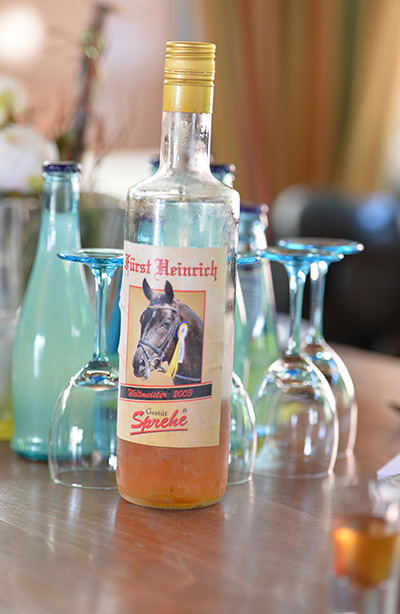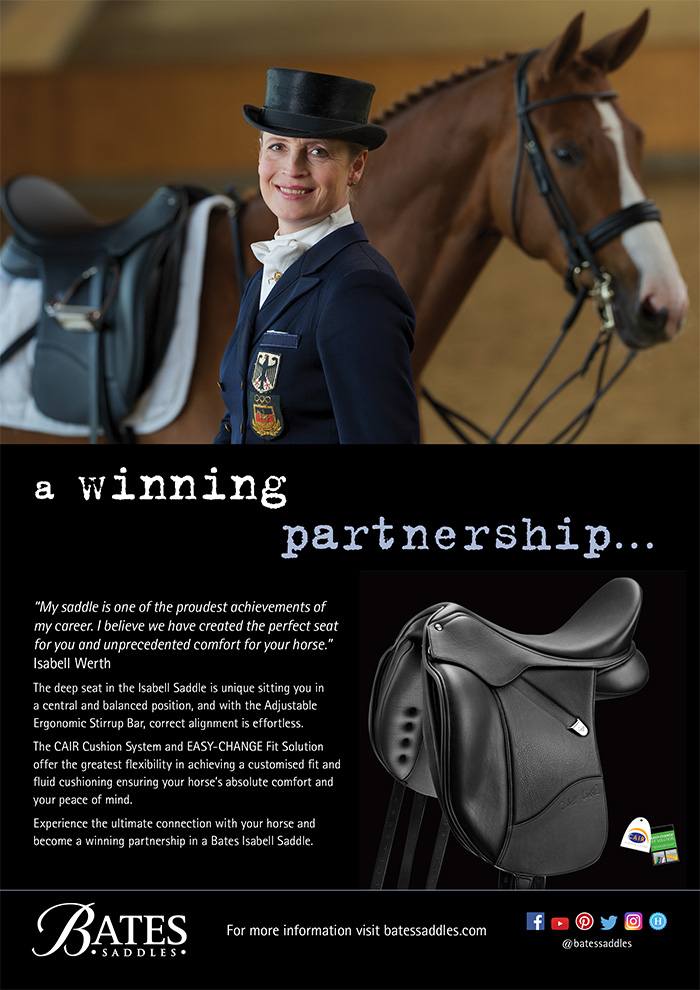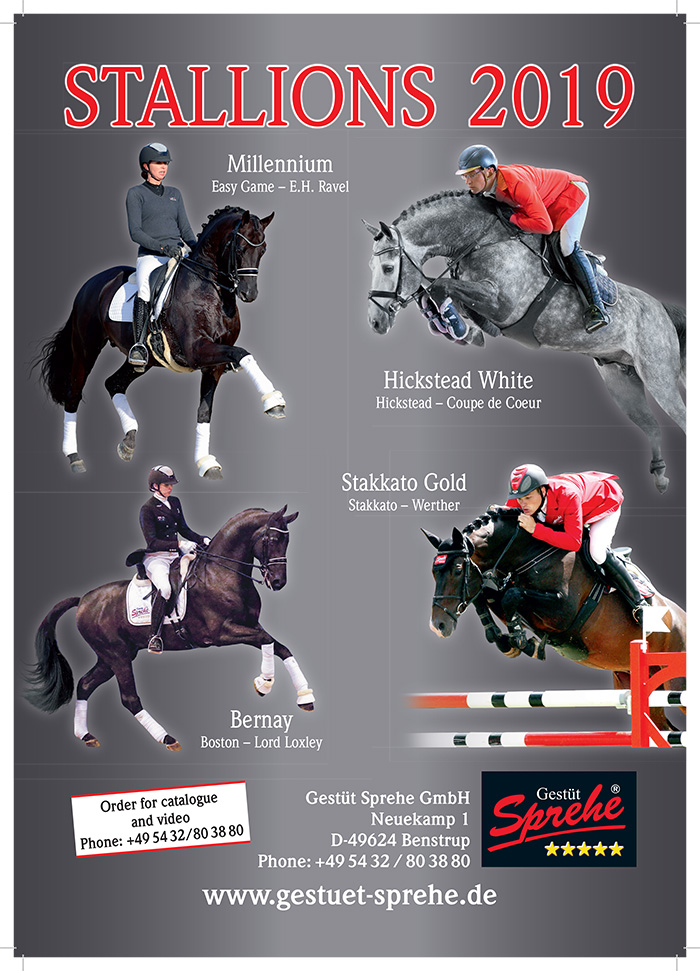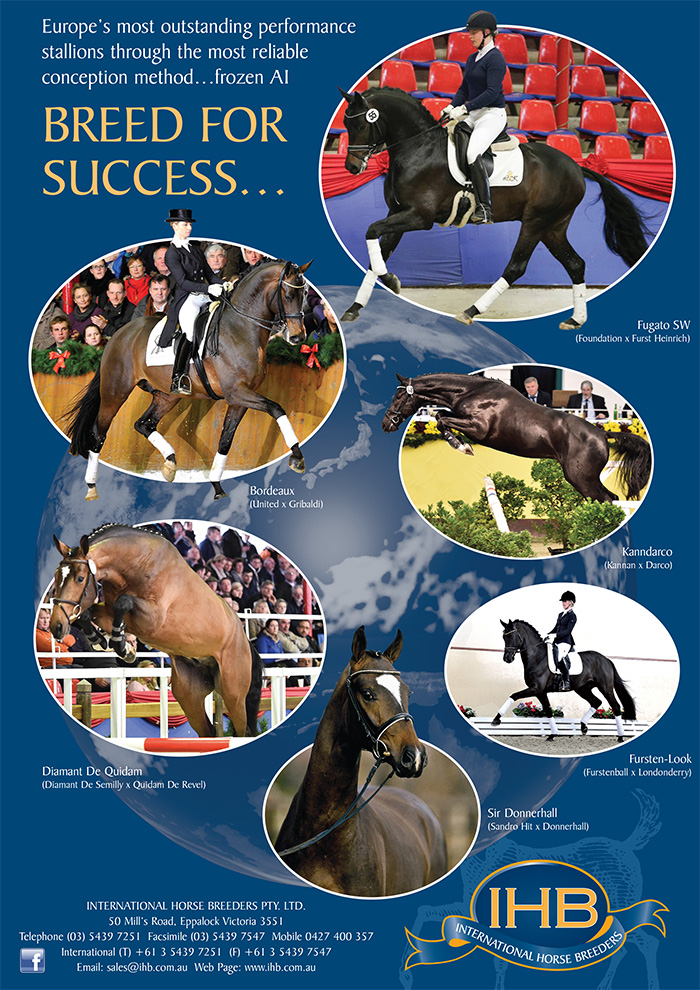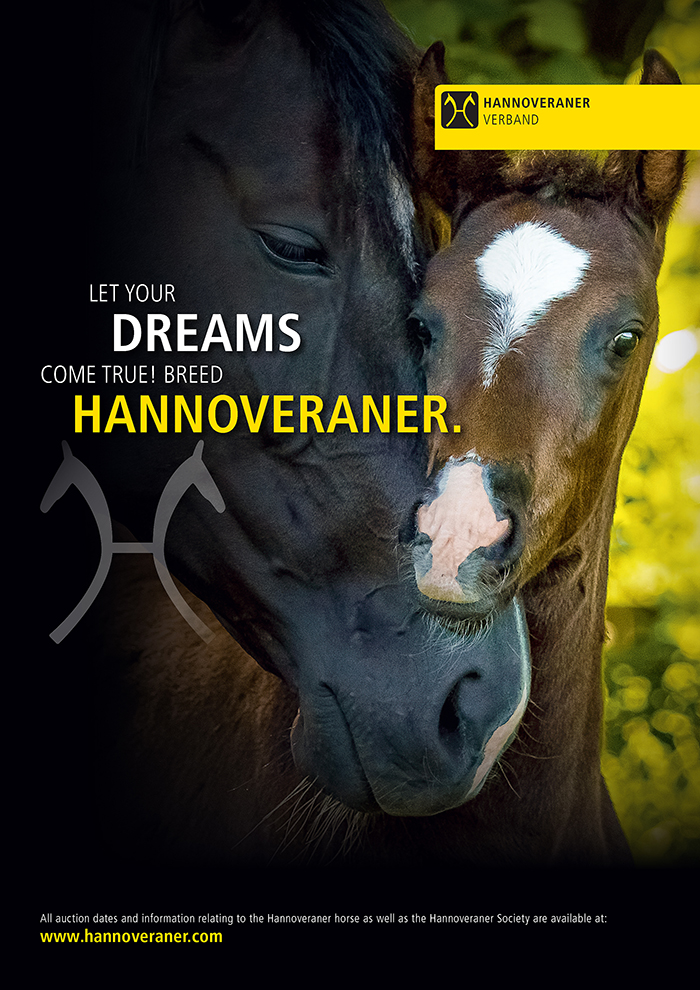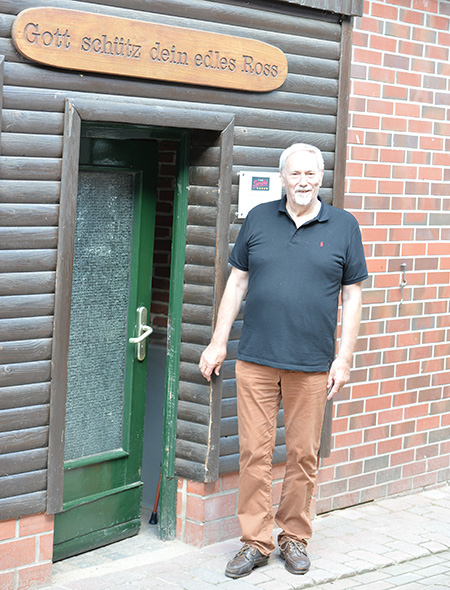
Interview: Christopher Hector
Photos: Roslyn Neave, Werner Ernst and archives
Dr Roland Ramsauer is a walking historical reference when it comes to horse breeding, particularly Oldenburg breeding – which is not surprising since he literally wrote the book: Das Oldenburger Sportpferd in collaboration with the photographer, Werner Ernst. The book was published in 1978, an absolutely crucial year in the transformation of the old Oldenburg Coach and Agricultural horse to the new Modern Sporthorse, and Roland as breeding director of the Oldenburg Verband, played a key rôle in that transformation.
Roland Ramsauer, at the age of 73, shows no sign of slowing down, and continues to help shape the destiny of one of Germany’s most successful studs – Sprehe – established in 2000.
I can remember at the time, some of the older established studs were saying, ‘oh it’s just another couple of rich guys, they won’t last long…’ and actually all the old studs have disappeared, and Sprehe is still standing! What has been the reason for the stud’s success?
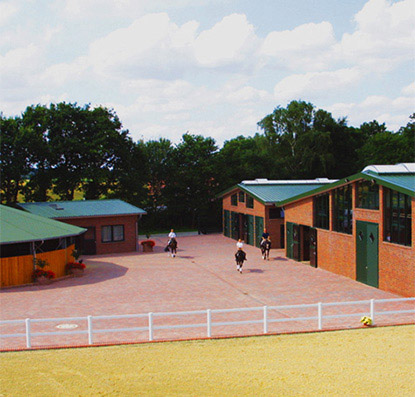
“The Sprehe Stud has been very successful because Mr Albert Sprehe has one very important idea. He said, I don’t want to see any breeder on my own stud – Roland you travel all over Germany and visit the breeders, talk to them, help them decide which stallions they want to breed with, and then we can be successful. It was very successful, and after two years, he said, Roland you cannot handle that any more, you need help, and that’s the reason we have six breeding advisors traveling around – and that is what makes it so successful because nowadays the farmers do not have so many workers that they can take the time to come and visit the stud. They have the catalogue, they have the DVDs to view the stallions, and they can still get the advice about their mare. I think that is why we are so successful – after Paul Schockemöhle and Van der Lageweg in the Netherlands, I think we are number three of the top breeding stations.”
Do you think one of the reasons the stud was successful was that you didn’t say, okay we are a stud in Oldenburg so we will just have Oldenburg stallions – right from the start Sprehe featured the top stallions from all the breeding associations, I think in the first year Sprehe stood five licensing champions from all over Germany…
“I think that is one part of the success, we don’t just breed Oldenburg or Hanover, we split that, and today we have roughly 90 to 100 foals a year, and 50 foals get an Oldenburg brand, 25% the Hanoverian brand and the rest will be split between Holstein and Westfalia, so that is the reason that we are working with all the breeding associations together.”
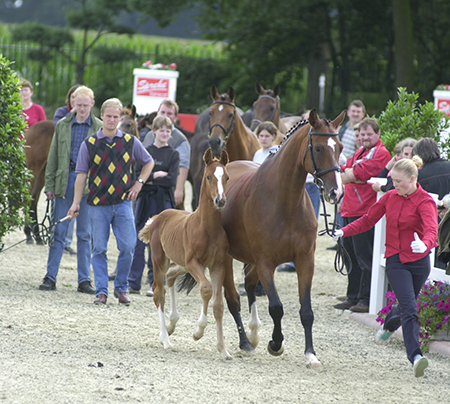
The Foal Show at Sprehe is a huge attraction
You would be very wrong to assume that Roland, because of his history with the Oldenburg Verband, was a dyed-in-the-wool fan of the breed, quite the reverse, he is looking to the day when all the breed associations are merged into one German Sporthorse book…
“Of course, when I started thirty years ago, the breeder would ask, Oh what breed is Hickstead White? Or what breed is Fürst Wilhelm – today nobody asks. They all ask what is the stallion doing, they only look to the pedigree and they don’t care if he has a Bavarian brand or an Oldenburg brand, or Netherlands or Holsteiner brand.”
Is there still an Oldenburg horse, or do we just have a German sport horse – with the possible exception of Holstein and the Trakehners…
“That’s exactly right. We have a German Sporthorse. Already in the south, the associations are working together and they don’t say Brandenburg or Bavarian or Bad-Württemberger, they call it the German Sporthorse. In the north it is a little bit different, still Oldenburg or Hanoverian or Westfalien but anyway, the customers who will breed and buy horses, don’t look at the brand, only the pedigree. If the pedigree is good, he buys the horse, for showjumping, or dressage, or whatever.”
Oldenburg history follows
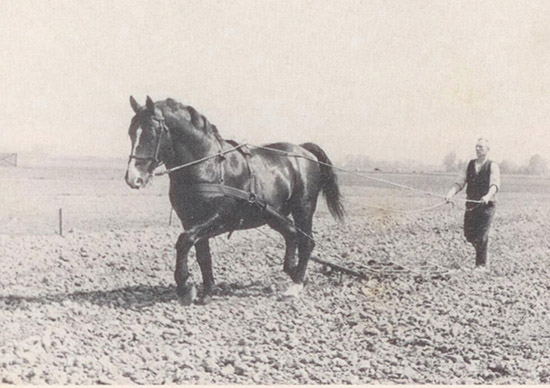
Those were the days, when even the breeding stallions could do a day’s work –
this is Furst who was born in 1940….
When I look at your history of the Oldenburger, there was a time when there was a real Oldenburger ‘type’, is it a little sad that we have lost something in the direction of uniformity?
“No it is not sad, because those people who wanted the heavier Oldenburg horse, wanted him for a coach horse or a working horse, and this time is gone. You must remember, when I started as a breeding director, we had 70% of our breeders were farmers who lived on what they made from their farms, today is just the opposite, 70% are professionals, engineers, lawyers, doctors, whatever – they normally have nothing to do with horses, and their income comes from their professions. They are looking for beautiful horses, and of course, performance in dressage or showjumping.”
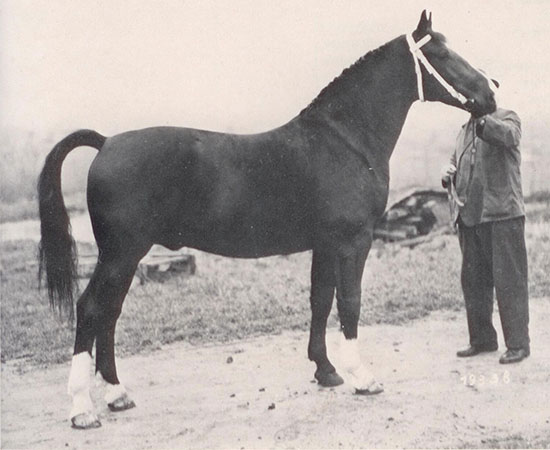
In the 60’s the Oldenburger was substantial, this is Charmant,
Champion Stallion, and born in 1960
I was at Aachen this year and the Donnerhalls were once again dominating the dressage, and I said to Jan Tönjes, the editor of St Georg, why? And he said, that in Donnerhall’s pedigree there was the blood of the Oldenburg coach horses, and that gave them soundness and the will to work – perhaps the Donnerhalls are drawing a little bit on this coach horse heritage…
“A little bit, I agree a little bit, those horses were calm, they liked to work, and so on, but they were not so elegant. Crossing them with other bloodlines and you get elegant horses that people like, and then comes the performance. In this case I would say Jan is a little bit right, but people don’t like the heavy type from thirty or forty years ago. They like the character and the temperament from the old Oldenburger, but they also like the performance which comes from the blood of the other breeding associations.”
The other day, Ludwig Christmann of Hanoverian Verband said to me that he thought Furioso II was THE most important stallion in sport horse breeding right now. You must have known the stallion well…
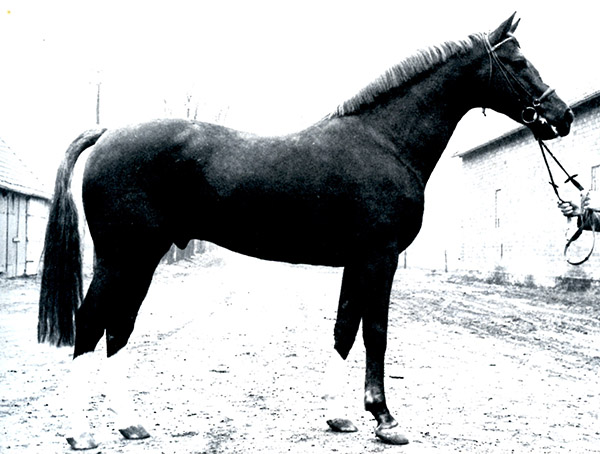
Furioso II – the French stallion that changed the Oldenburg breed
“Of course I know the stallion, because when I started he was five or six years old and he was very successful. At that time, he was covering 450 mares per season, natural covering! I was a university student at the time, and the professor told me, with natural serving a stallion can cover a maximum of 200 mares. I said, Mr Professor, I am sorry but I know a stallion that covers over 450 mares. He said, I don’t believe that. Then I will invite you to come to the station of Mr Vorwerk and there you can see that Furioso covers for the first time in the morning, at five o’clock, at eight o’clock, for the second time, twelve o’clock, the third time. Three o’clock in the afternoon for the fourth time and seven o’clock in the evening for the fifth time, in the main season, May, June, July. The professor saw it for himself, unbelievable, then Mr Vorwerk said, let’s go to the dining room and have a Schnapps. The whole day, and up till the next morning, they were drinking and talking about Furioso and how he was found in France.”
“There is another story. When I had been the breeding director for six months, I met Dr Lehmann, the Director from Westfalia, and a very intelligent, well-educated man. He said to me, Herr Ramsauer, you are a nice man, and I will tell you one thing, how can you breed with this stallion who belongs in the zoological gardens, Furioso II? I said, Dr Lehmann, that is not your job, that is my job and we believe that we can be successful with the breed of Furioso II, that will be the success of the Oldenburger. And then, I think eighteen years later, there was Florestan, the big stallion in Westfalia, and I said, Oh Dr Lehmann you are breeding with this zoological stallion from France and you get Florestan, what do you think about that? He said, Florestan, that’s another story – I said it’s not another story, it’s a grand-son of Furioso II. Then he stopped talking about zoological things.”
What was it about Furioso II that made him great? There were a number of horses that came from France at that time, but only two of them, Cor de la Bryère and Furioso, worked, and there must have been another 15/20 that disappeared…
“You’re right, that was our problem too, to find another stallion after Furioso II. Vorwerk and I, we were traveling every year to France looking for stallions, and we tried three or four but they were not successful. Only Furioso II, with his Thoroughbred sire line, that fitted our breed so successfully.”
What did he give?
“He gave everything. Performance, for showjumping horses, for dressage horses, three-day event horses. Mr Vorwerk, he was a genius, if he had not been there, I think Oldenburg might have gone to merge with Hanover, but he said, Oldenburg is Oldenburg and Furioso is Furioso, and he and Inschallah, the Anglo Arab, they are Oldenburg. The smart thing he did was that he had breeders around him, and they all had excellent mares – and he said, you never sell a filly, you keep it, and I will organize the next generation for you. And the breeders believed him and that is why he was so successful. And they believed in him when he said, you have to change, go to Inschallah, go to Westminster, you go to Furioso. They believed the words of this outstanding breeder, Mr Vorwerk.”
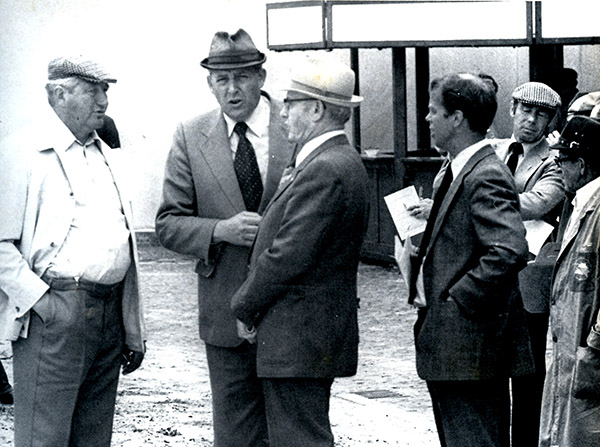
Vorwerk – the genius – is on the left, the others, left to right: B. Meinardus, L. Kathmann, W. Schockemöhle and O. Ammermann
He must have been an extraordinary man…
“An extraordinary man! We talked together a lot, and maybe that was the reason for my success, I believed what he said. On his 55th birthday, he phoned me at one o’clock in the afternoon – Ramsauer you have to come, we’ve got to talk a little bit, there are three mares that have to be registered. I said, okay I’m coming. He sent his wife and daughter shopping, so he was home alone. Oh it’s only one mare but we have to talk – and we were talking three or four hours: What is going on with this bloodline? What is going on with the Thoroughbred? What is going on with the Hanoverians? He said with the Hanoverians you had better be careful, better you can take Thoroughbred over your own breed – and then take the stallions of the F1, F2 or F3 generation, and that was his success and the success of the Oldenburger, that he was always careful at the beginning. Today it’s another world, you can take Oldenburger, Hanoverians, Holsteiner, whatever you like. But at that time, he said, we must be successful, we must sell the horses, and that only happens when we take a shot of Thoroughbred blood – every horse should have in the third or fourth generation, Thoroughbred – that can be the secret of our success.”
When I look at the photos in your book, there were ten or fifteen magnificent Thoroughbred stallions, fabulous looking horses – how did Oldenburg get these stallions?
“That’s another story. I was the breeding director for 26 years and we went every second week, to the racetrack. In the morning at six o’clock, we were in Cologne, we were in Düsseldorf, we were in Munich, looking for the right type, and the really good canter. Then we looked for the temperament. We went with Mr Vorwerk, with Mr Kathmann, with Mr Werner Schockemöhle, and that was our success at that time that we found the right stallions. We did that every second week for three or four seasons. At that time, 1972, of the whole mare population, 45% were covered by Thoroughbred stallions, and that is how we came successfully from the heavy type to the elegant type. That was three years in a row that we had over 40% covered by Thoroughbred stallions, and they were, as you said, magnificent: Miracolo, Volkorn, More Magic, Makuba, Manolete, and the three quarters, Volturno – that was our success.”
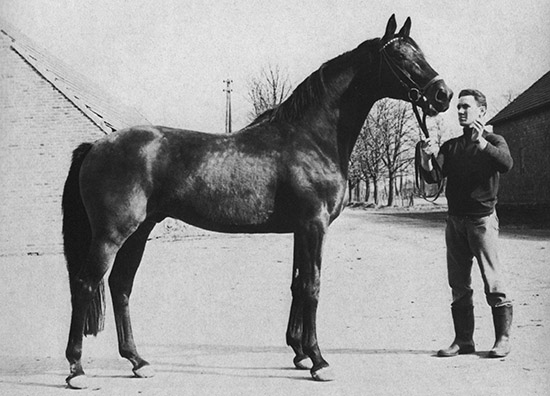
Miracolo
To see all these fantastic Thoroughbreds and get more information about the Thoroughbred lines in Oldenburg today – click here
How did you get into all this, did you come from a family that had horses?
“My father was an engineer and my mother was a translator, but the horses came from my grandfather. My grandfather wanted to be a farmer, but his father was a teacher, and he said, no, you don’t be a farmer, you can be a teacher or a priest. So he studied theology and became a priest, but he was more a farmer than a priest. Every evening he goes to a farmer, look for horses, look for cattle, and then he drinks two or three schnapps and then he goes home – so I think I have it from that side. When I was fourteen I made the decision – I want to be maybe a farmer if I find the right wife, and on the third farm I was working on, the farmer said to me, Roland forget your idea with the horses, because the horse business was going down and down. The Oldenburg Society had once had 20,000 mares, but by 1972, only 1000 mares. My boss said, milk and beef we need all the time, look to the cattle. So I studied cattle, then came from the Oldenburg Society the offer – do I want to be the breeding director? But I know nothing about horses. You will learn, we have heard that you study cattle and if you can judge cattle, you can also judge horses.”
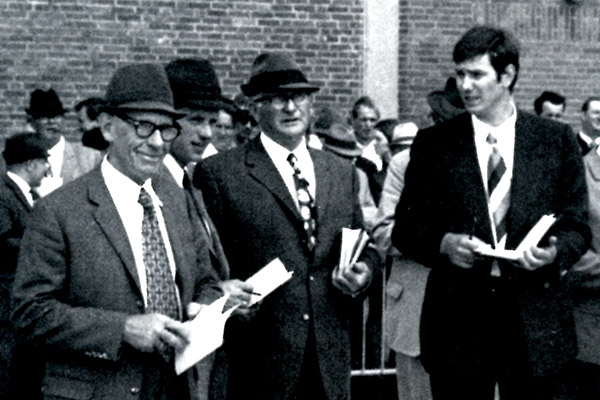
That’s the recently appointed Breeding Director, young Roland with the 1973 Oldenburger Commission – on his right are J. Albers, the President, Graf v. Merveldt and F. Folkers.
Somewhere along the way, you picked up a Phd and became Dr Ramsauer, what did you study?
“I studied cattle production and horse production and sheep production. No pigs. I made my Master Degree, about the breeding values of cattle.”
How do you see the future of what we might now call the German Sport Horse?
“To be very honest, and my colleagues will kill me, I think in 20 years, we will have one horse association, German Horse Association and we will breed the German Sporthorse, everywhere – and you will have the Department Oldenburg, the Department Hanover, the Department Holsteiner, I think the only one that will not be there is the Trakehner. The Trakehner will be independent for themselves, they can do what they want. The others will all be in one association, with their special departments, like the Dutch, KWPN, like the French, Selle Français, and in 20 years, I think it will be the same in Germany.”
Do you still find it exciting to go out and try to find a new young stallion, or a special mare?
“Still! My wife says, go to work and look to your horses… I’m traveling sometimes 800, 900 kilometres a day, but I like to see horses, to look for young stallions. I think there is a good future and that the horse industry will grow again. We see that with our stud, last year we had 15% more, this year I think 18-20% more, so that’s a good future for the Sprehe stud, and German horse breeding.”
more below
When did you first see Desperados?
“I saw him when he was two-and-a-half years, Paul Sprehe asked what about this stallion? It’s a super stallion. And he was at that time not licensed! I said you can buy him, he’s a super dressage horse. So Paul bought him for 105,000 deutschmarks. He was the most expensive unlicensed stallion at that time.”
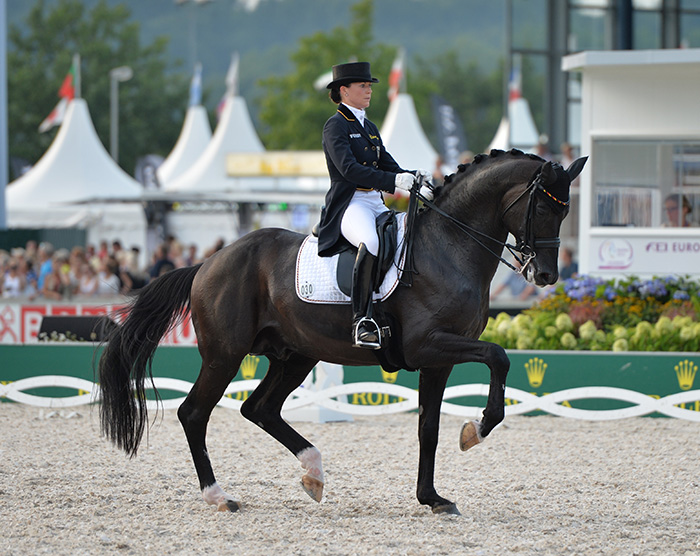
Desperados – likes mares with Thoroughbred blood
He’s been a fabulous competition horse but how do you think he’ll rate as a breeding stallion? What will he give?
“He was a super type and he was moving like that when he was free running – we couldn’t believe that the Stallion Committee of the Hanoverians rejected him. The head was my friend from university days, ‘Johnny’ Wilkens, and I said to him, thank you, you had such blind eyes this day!”
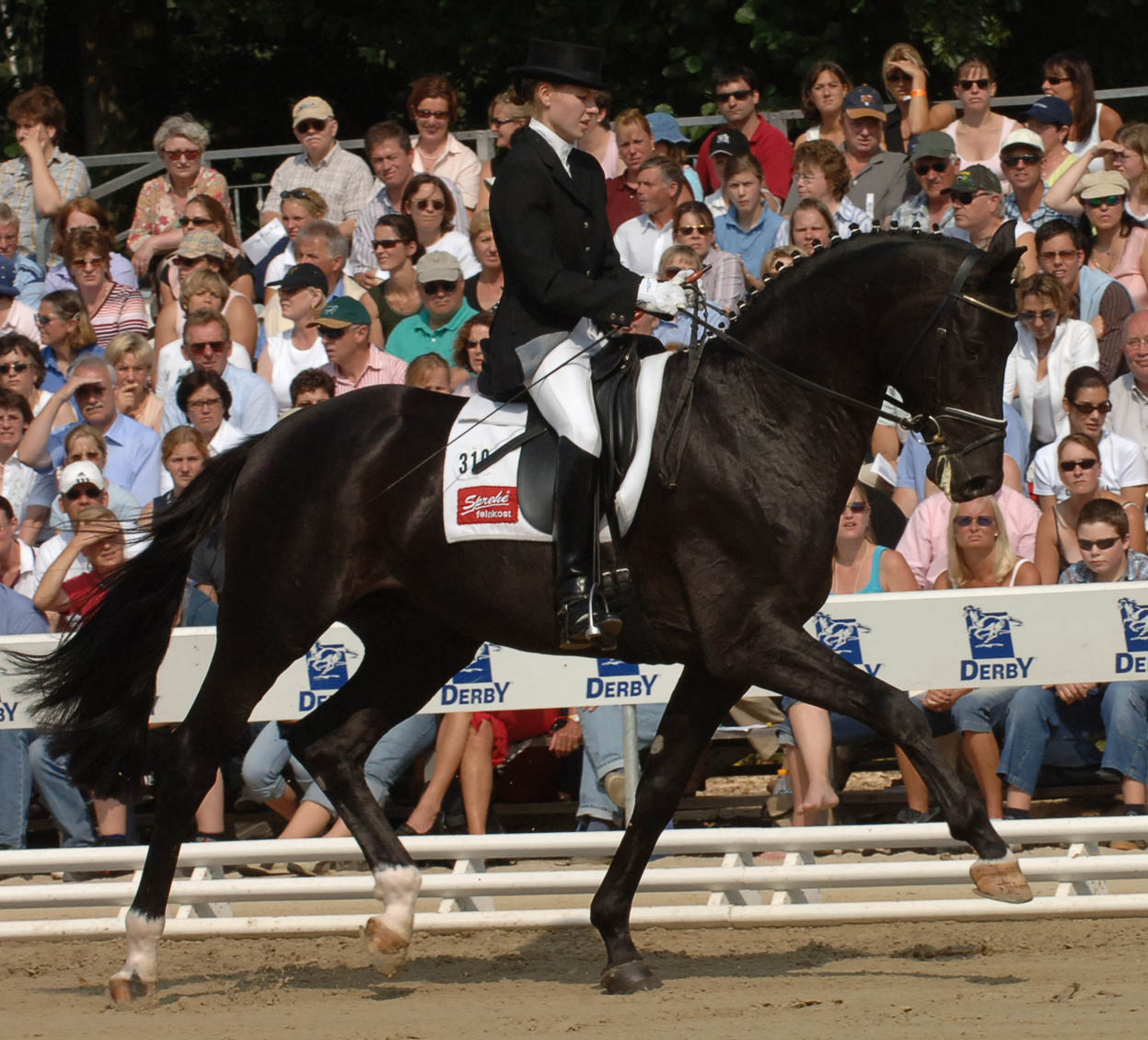
Desperados as a four-year-old
What mares do you think Desperados fits best with?
“He should have mares that have Thoroughbred blood, that is most important. They should be medium size, not too big, not too small and they will inherit, of course, the movement, so the mares can have not so much movement because he will improve the movement of the offspring.”
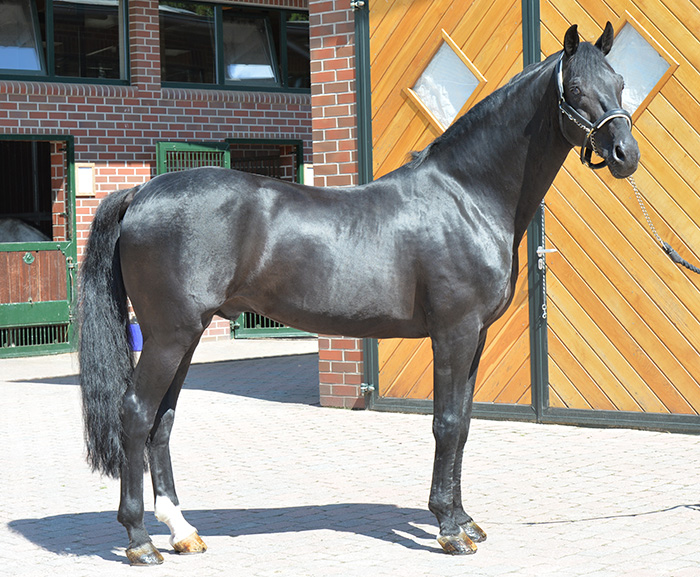
Fürst Wilhelm – another who crosses well on ‘blood’
With Fürst Wilhelm, what mares would you advise the breeders to use?
“You definitely need mares which have a little bit of Thoroughbred blood in the pedigree. That’s the most important. He can also breed to mares that are a little hot, because he makes the offspring calm.”
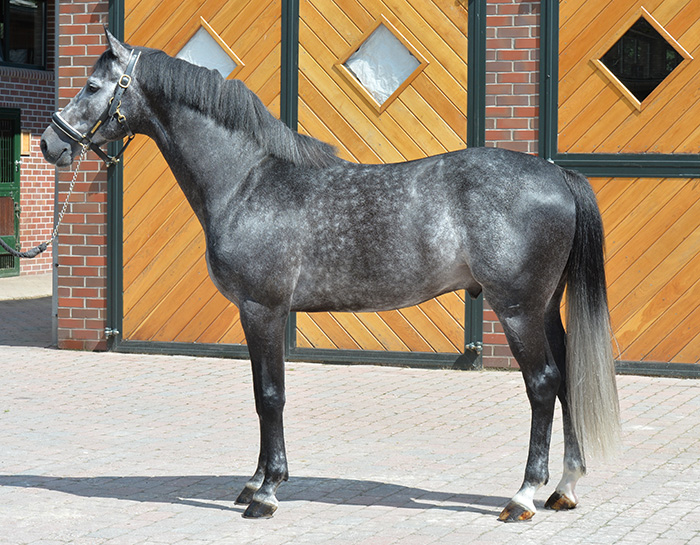
The only licensed son of Hickstead in the world – Hickstead White
and – below – his dam, Queen Tina who is currently competing 1.60m.
Queen Tina is by Coupe de Coeur out of a mare by Quidam’s Rubin, who stood at Sprehe from 2002 until his untimely death in 2007.
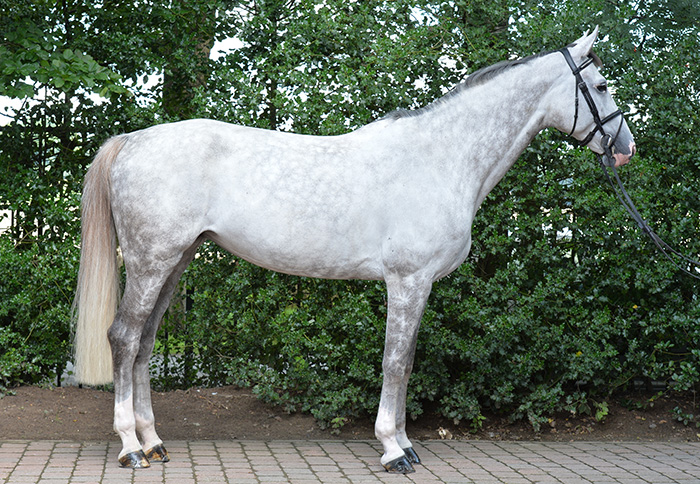
The grey, Hickstead White, what mares for him?
“He can take any mare. It’s amazing, you can take a small mare, you can take a big mare, he is such a super type inheritor and the same with the movement. It’s an outstanding stallion.”
next we talk bout Fürst Heinrich, Sprehe’s first stallion star.
Fürst Heinrich has been such an influential stallion for one who died so young…
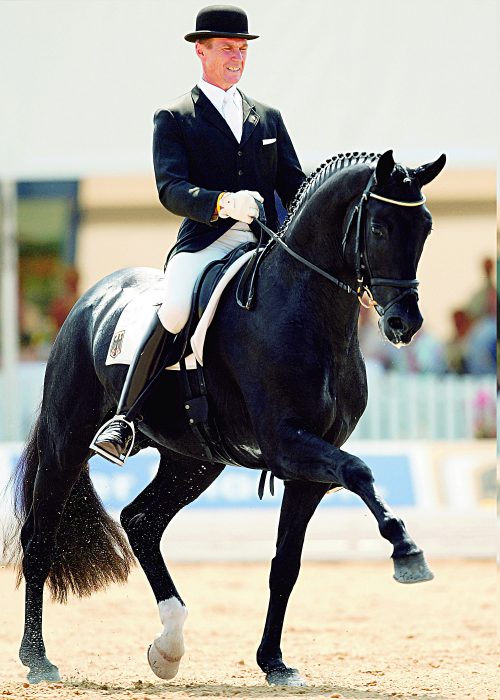
“When he was licensed in 2000, it was December 4 – at that time the name of the stallion was FloDonWei, after the first letters of Florestan, Donnerhall and Weinberg – at 6.30 in the morning I got a call from Mr Sprehe, Doctor, we have to change the name of FloDonWei. Oh my god, I just sent the registration yesterday to Warendorf… No, the new name is Fürst Heinrich. Why? Very easy, the wife of the auctioneer said to me, this is an awful name, why don’t you call him Fürst Heinrich – the Duke of Heinrich – because the breeder and the raiser of the stallion is Mr Ramsbrock, Heinrich Ramsbrock – and that’s why he got the name Fürst Heinrich.”
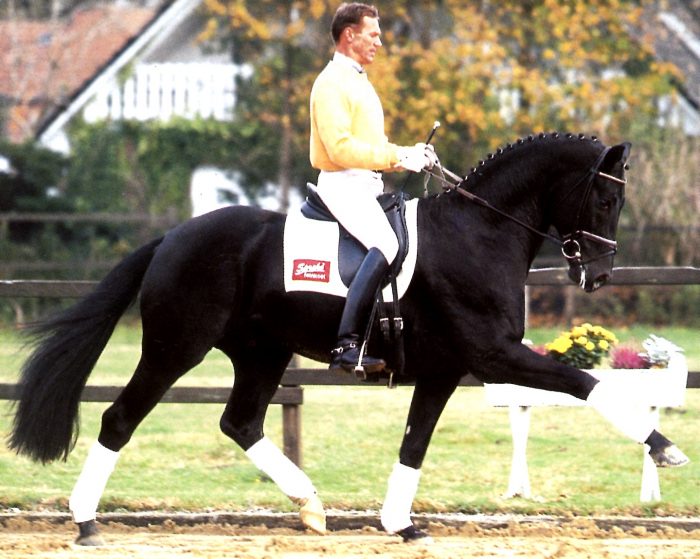
He only had a short life as a breeding stallion, what made him so good?
“In the first year he stood, Albert Sprehe said to me, Doctor, you travel all over Germany looking for the first Fürst Heinrich offspring, colts and fillies, select them, and then I will go with the Commission after, to look if you were right or not – do your best. I had three weeks, we were traveling day and night with two drivers, sometimes coming home at 4 am, sleep two hours, then take another driver, looking for the best. And like Hickstead is now, it was uniform, they could walk, they could trot and they have a type. That was the beginning of the career of Fürst Heinrich.”
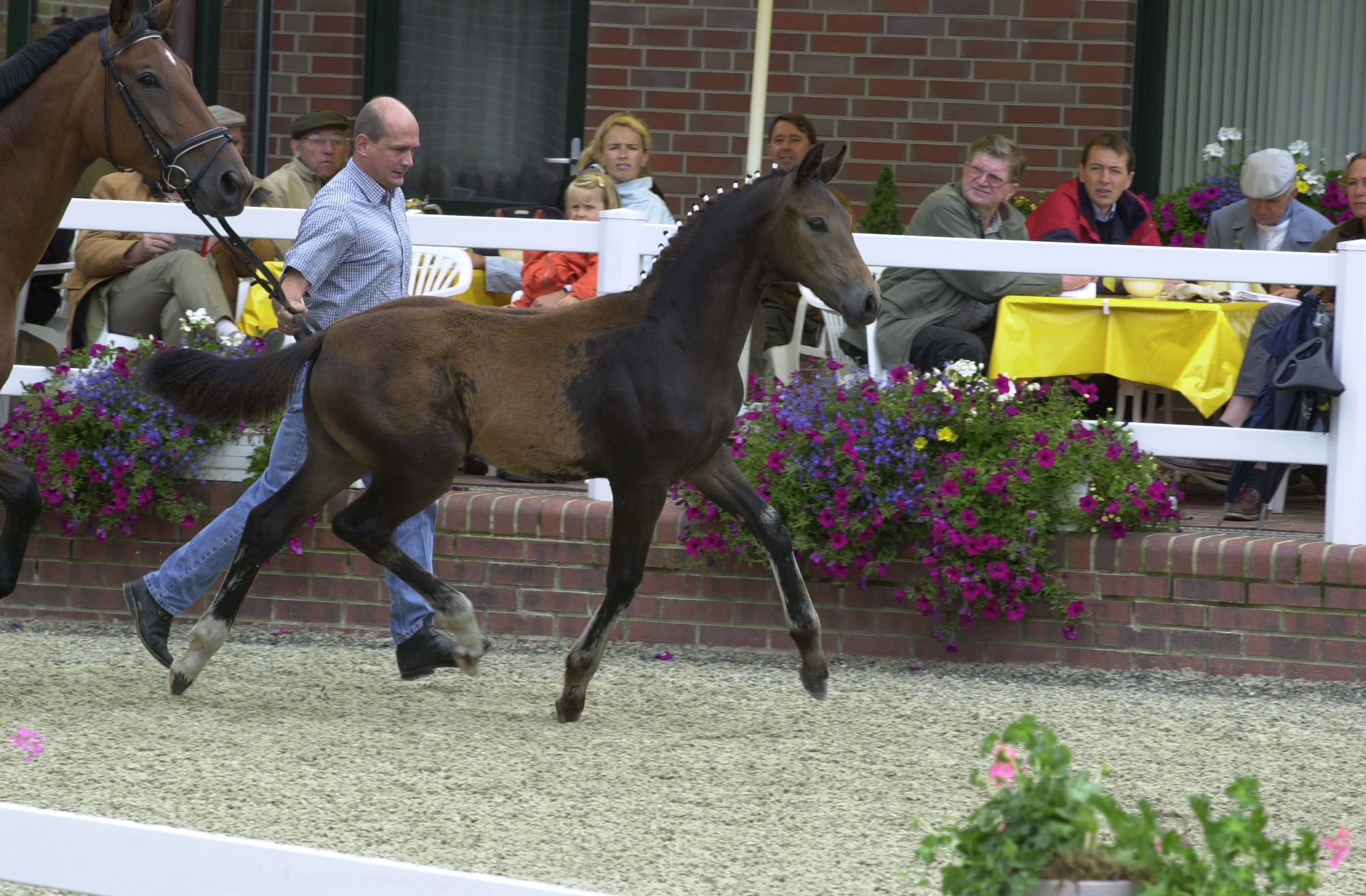
By Fürst Heinrich out of an Argentinus mare, at the 2002 Foal Show
But it is much harder these days surely – once the mares around the little stallion station, they all bred to the local stallions, generation after generation, so you ended up with a mare population that was very similar, and if the stallion worked with one mare, it worked with all of them – and this gave a chance for a new stallion to make a name, but now it is very hard for the outcross to find mares…
“Hickstead, he is the outcross stallion, you can use him to any mare. You can breed him to a dressage mare, a showjumping mare, a three-day event horse, he makes all the time super foals.”
Was Inschallah important?
“Yes, he was very important because he refined the type, he needed mares of a medium size but he had a very good character, and a super type. He had good dressage horses. Of course, at the time, he delivered a lot of grey horses, and at that time the people liked not so much a grey horse.”
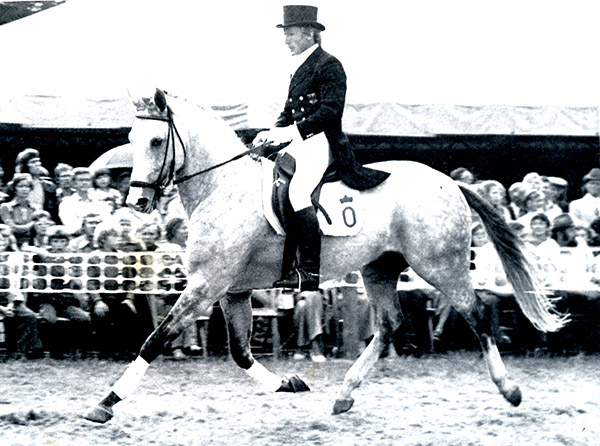
Is it a little sad now – when I started writing about breeding, it was said in Oldenburg, our strength is the great stallion stations, but now they are gone – Kathmann, Vorwerk, Seifert – gone…
“That’s the problem. We were talking about it a couple of nights ago. I had a meeting with Dr Schleppinghof and Dr Heiko Meinardus, the editor of the Oldenburg magazine, and we were talking about writing a new book about the Oldenburg breed – it will take time, it will not be finished in three months, maybe one year. And we were discussing this problem – when I started in 1972, we had 32 stallion stations. In every district there were five or six stations, most with just three stallions – only Kathmann, Vorwerk and Schockemöhle had more. Now today we have Paul Schockemöhle, Sprehe, Böckmann, Klatte, Gerd Sosath… It’s a big change.”
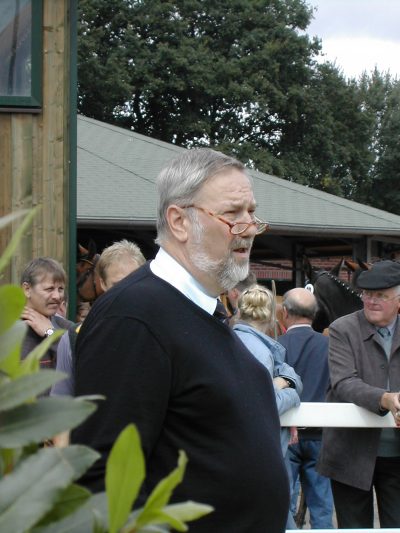
I treasure my copy of Roland’s first book, and look forward eagerly to the second, and thank him for his time, and thank Nadine Heidrich of the Sprehe Stud who arranged our interview… and yes, thanks for the Schnapps.
